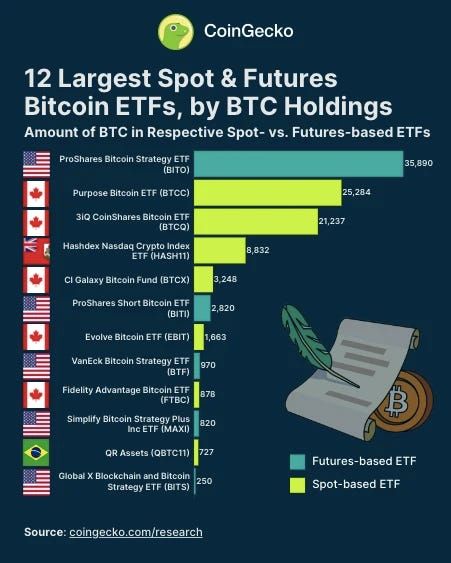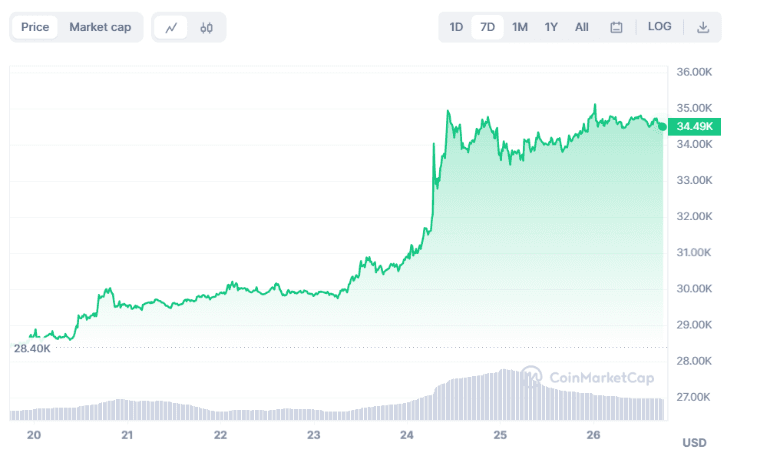Today’s BTC Price
As of now, the current price of Bitcoin stands at $34,097.77 per (BTC / USD), boasting a total market capitalization of $665.79 billion USD. Over the past 24 hours, there has been a trading volume of $15.51 billion USD. The BTC to USD price is continually updated in real-time. Furthermore, Bitcoin has experienced a slight decrease of -0.04% in the last 24 hours, with a circulating supply of 19.53 million.
Bitcoin (BTC) in Brief
Bitcoin, initially introduced in 2009 by the enigmatic Satoshi Nakamoto, ranks as one of the most widely recognized cryptocurrencies in the market. In terms of market capitalization, it has consistently held the top spot, setting the stage for the emergence of numerous other alternative coins (altcoins). Bitcoin marked a watershed moment for digital payment solutions.
Being the world’s pioneer cryptocurrency, Bitcoin’s value has evolved significantly. Importantly, one doesn’t need to purchase an entire Bitcoin, as it can be subdivided into smaller units known as satoshis, a tribute to its creator. A satoshi is the equivalent of 0.00000001 Bitcoin.
Bitcoin functions solely as a digital currency and lacks a physical token. Transactions involving Bitcoin are fully transparent and immune to censorship, establishing a global, censorship-resistant medium for financial exchanges. It operates as a financial system supported by a decentralized network of computers, referred to as “nodes,” rather than relying on centralized banks or government entities, thereby championing “decentralization.”
What Drives Bitcoin’s Price Volatility?
Since its inception, Bitcoin’s price has been marked by high volatility, attributed to various factors. Firstly, the cryptocurrency market is comparatively smaller and less actively traded than traditional financial markets, making it susceptible to substantial price swings triggered by significant transactions. Secondly, Bitcoin’s value is influenced by public sentiment and speculation, which can lead to short-term price fluctuations. Media coverage, influential opinions, and regulatory developments create uncertainty, impacting demand and supply dynamics and contributing to price oscillations.
An additional crucial factor is Bitcoin’s fixed supply. With only 21 million Bitcoins set to ever exist, its scarcity can result in drastic price shifts depending on demand. This is further exacerbated by the actions of “whales,” large Bitcoin holders, whose substantial transactions can substantially influence the market.
When Was Bitcoin Invented?
Bitcoin came into existence in 2009, conceived by an anonymous individual or group operating under the pseudonym Satoshi Nakamoto. This digital asset is underpinned by a decentralized, peer-to-peer network and blockchain technology, allowing users to conduct secure and anonymous transactions without intermediaries. In 2008, Satoshi Nakamoto published the Bitcoin whitepaper, outlining the cryptocurrency’s design and principles. The first-ever Bitcoin transaction, entailing the transfer of 10 Bitcoins to a developer, occurred on January 12, 2009. Since then, Bitcoin has gained traction as an alternative store of value and payment system, reshaping the financial industry.
Who is the Creator of Bitcoin?
The creator of Bitcoin remains a mystery, known solely by the pseudonym Satoshi Nakamoto. The innovation behind Bitcoin surfaced in 2008 when Nakamoto released the whitepaper elucidating the cryptocurrency’s decentralized, peer-to-peer structure and utilization of blockchain technology. In 2009, Nakamoto mined the inaugural Bitcoin block, with the first Bitcoin transaction transpiring on January 12th of the same year. Despite extensive investigations and conjecture, the genuine identity of Satoshi Nakamoto has remained undisclosed.
Numerous individuals have been proposed as potential Satoshi Nakamoto candidates, but none of these claims have been definitively substantiated.
How Does Bitcoin Operate?
Bitcoin operates on a decentralized, peer-to-peer network, enabling individuals to execute transactions without intermediaries. The transparency and security of transactions are maintained through the underlying blockchain technology, which stores and verifies recorded transaction data. Miners validate transactions by solving intricate mathematical problems through computational power. The initial miner to find the solution receives a cryptocurrency reward, leading to the creation of new Bitcoins. Once validated, the data becomes a permanent record in the existing blockchain. Bitcoin offers an alternative, transparent, and secure method of transaction, redefining traditional finance.
When is the Next Bitcoin Halving?
The upcoming Bitcoin halving is anticipated to occur in April 2024. The precise date is contingent on the block height, denoting the number of blocks preceding a specific block in the blockchain. Bitcoin experiences a halving approximately every 210,000 blocks, with the next halving expected in April 2024 when the block height reaches 840,000.
Bitcoin halving events, which take place roughly every four years, involve reducing the rewards granted to Bitcoin miners for block mining by half. This was integrated into the Bitcoin protocol to sustain its value as a deflationary currency. By decreasing the issuance of new Bitcoins, the protocol aims to counteract the devaluation that frequently affects inflationary currencies over time.
Will Bitcoin Halving Impact BTC’s Price?
Historically, Bitcoin’s price has exhibited an upward trajectory in the months leading up to a halving event, as investors and traders anticipate a reduction in the supply of new Bitcoins. Post-halving, the price may continue to rise if demand remains robust and surpasses the diminished supply. Additional factors such as market sentiment, regulatory developments, and global events can also exert influence on Bitcoin’s price. Keep an eye on our Bitcoin Halving Countdown to gain insights into the mechanics of Bitcoin halving.
For the most up-to-date Bitcoin (BTC) prices, please visit Binance, where live price information is available in real-time.
Analyzing the Factors Behind Today’s Surge in Bitcoin Price
Introduction
Bitcoin, the world’s leading cryptocurrency, has been making headlines today as its price experiences a notable surge. The reasons behind such sudden fluctuations in the value of Bitcoin are multifaceted and influenced by a combination of factors, including market sentiment, technical indicators, and external events. In this report, we will delve into the key factors contributing to the rise in Bitcoin’s price today.
Market Sentiment and Investor Confidence
Market sentiment plays a pivotal role in shaping the price of Bitcoin. Positive sentiment, often fueled by optimistic news and events, can trigger a buying frenzy, leading to an upswing in the cryptocurrency’s value. Recently, the sentiment around Bitcoin has been largely positive, driven by several factors:
a. Regulatory Clarity: The regulatory landscape for cryptocurrencies is slowly becoming clearer in various parts of the world. When regulators provide a structured and transparent framework for cryptocurrency operations, it tends to boost investor confidence. In regions like the United States and the European Union, progress in regulating the crypto space has contributed to the bullish sentiment.
b. Institutional Adoption: Large financial institutions and corporations are increasingly recognizing the potential of Bitcoin as a store of value and a hedge against inflation. Investments from major players, such as Tesla and Square, have been driving confidence in Bitcoin as a legitimate asset.
c. Global Economic Uncertainty: Economic turmoil and currency devaluation in some countries have driven individuals and institutions to seek refuge in Bitcoin, which is often seen as a safe-haven asset similar to gold.
Technical Analysis and Chart Patterns
Traders and analysts often rely on technical analysis and chart patterns to make investment decisions. Certain technical indicators can signal buy or sell opportunities, influencing the actions of traders and investors. Today’s surge in Bitcoin’s price may be partly attributed to these technical factors:
a. Golden Cross: A “golden cross” occurs when a short-term moving average crosses above a long-term moving average. This event is often seen as a bullish signal, suggesting that positive momentum is building, and traders should consider entering long positions. The occurrence of a golden cross can attract traders and investors, contributing to a price rally.
b. Breakout Patterns: Traders pay close attention to chart patterns, such as “bull flags” and “cup and handle” formations, which can signal a breakout to the upside. When these patterns emerge and are confirmed, traders often take long positions, which can drive the price higher.
Global Events and News Catalysts
Cryptocurrency markets are highly responsive to external news events, which can act as significant catalysts for price movements. Several events or developments have been influencing Bitcoin’s recent surge:
a. El Salvador’s Adoption: In September 2021, El Salvador became the first country in the world to adopt Bitcoin as legal tender. This historic move has drawn global attention to the cryptocurrency and its potential for international adoption.
b. Macro-Economic News: Economic events, such as changes in interest rates, inflation reports, and geopolitical tensions, can affect Bitcoin’s price. Traders often turn to Bitcoin as a hedge against economic instability.
c. Institutional Investments: Announcements of large institutions or companies adding Bitcoin to their balance sheets can significantly impact market sentiment and drive the price up. The “smart money” is often followed by retail investors.
Supply and Demand Dynamics
Bitcoin’s price is also influenced by its supply and demand dynamics, which are inherent to its design. With a fixed supply cap of 21 million coins, changes in demand can lead to price surges:
a. Halving Events: Bitcoin experiences a “halving” approximately every four years. During a halving, the reward given to miners for confirming transactions is reduced by half. This supply reduction has historically been associated with price increases, as it highlights the scarcity of new coins.
b. Scarcity and FOMO: As more investors and institutions recognize Bitcoin’s scarcity, the fear of missing out (FOMO) can drive up demand. Investors rush to buy Bitcoin to secure their share of a limited supply.
c. Hodling Behavior: A significant number of Bitcoin holders adopt a “hodling” strategy, which means they keep their coins long-term rather than actively trading them. This behavior further restricts the available supply and can lead to price appreciation.
Conclusion
The surge in Bitcoin’s price today is the result of a complex interplay of factors, ranging from market sentiment and technical analysis to external events and supply and demand dynamics. As the cryptocurrency market continues to mature and gain recognition as a legitimate asset class, Bitcoin’s price movements will likely remain subject to both rapid fluctuations and long-term trends.
Investors and analysts should remain vigilant and consider a holistic approach when assessing the cryptocurrency market. While today’s rise in Bitcoin price may be a momentous event, it serves as a reminder that the cryptocurrency landscape is dynamic and influenced by a multitude of factors, making it a continually intriguing and challenging space for traders and enthusiasts alike.









